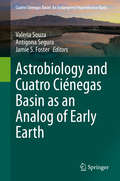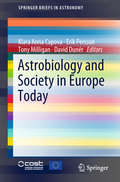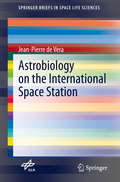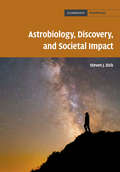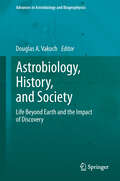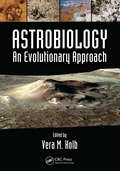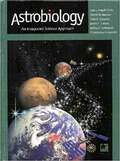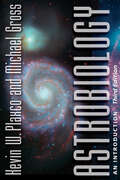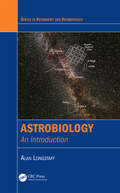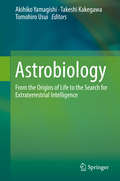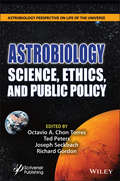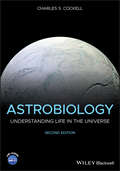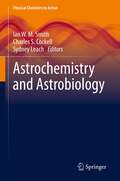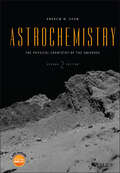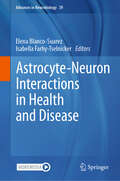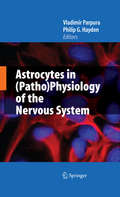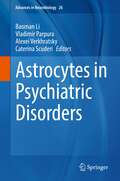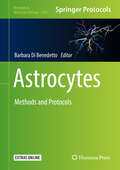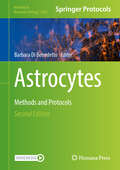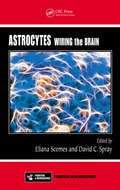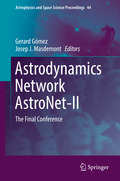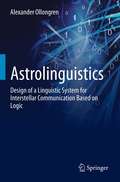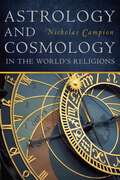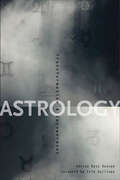- Table View
- List View
Astrobiology and Cuatro Ciénegas Basin as an Analog of Early Earth (Cuatro Ciénegas Basin: An Endangered Hyperdiverse Oasis)
by Valeria Souza Antígona Segura Jamie S. FosterAstrobiology not only investigates how early life took hold of our planet but also life on other planets – both in our Solar System and beyond – and their potential for habitability. The book take readers from the scars on planetary surfaces made by space rocks to the history of the Solar System narrated by those space rocks as well as exoplanets in other planetary systems. But the true question is how life arose here or elsewhere. Modern comparative genomics has revealed that Darwin was correct; a set of highly conserved genes and cellular functions indicate that all life is related by common ancestry. The Last Universal Common Ancestor or LUCA sits at the base of the Tree of Life. However, once that life took hold, it started to diversify and form complex microbial communities that are known as microbial mats and stromatolites. Due to their long evolutionary history and abundance on modern Earth, research on the biological, chemical and geological processes of stromatolite formation has provided important insights into the field of astrobiology. Many of these microbialite-containing ecosystems have been used as models for astrobiology, and NASA mission analogs including Shark Bay, Pavilion and Kelly Lakes. Modern microbialites represent natural laboratories to study primordial ecosystems and provide proxies for how life could evolve on other planets. However, few viral metagenomic studies (i.e., viromes) have been conducted in microbialites, which are not only an important part of the community but also mirror its biodiversity.This book focuses on particularly interesting sites such as Andean lake microbialites, a proxy of early life since they are characterized by very high UV light, while Alchichica and Bacalar lakes are characterized by high-salt and oligotrophic waters that nurture stromatolites. However, it is only the oasis of Cuatro Ciénegas Basin in México that stored past life in its marine sediments of the Sierra de San Marcos. This particular Sierra has a magmatic pouch that moves the deep aquifer to the surface in a cycle of sun drenched life and back to the depths of the magmatic life in an ancient cycle that now is broken by the overexploitation of the surface water as well as the deep aquifer in order to irrigate alfalfa in the desert. The anthropocene, the era of human folly, is killing this unique time machine and with it the memory of the planet.
Astrobiology and Society in Europe Today (SpringerBriefs in Astronomy)
by Tony Milligan David Dunér Klara Anna Capova Erik PerssonThis White Paper describes the state of astrobiology in Europe today and its relation to the European society at large. With contributions from authors in twenty countries and over thirty scientific institutions worldwide, the document illustrates the societal implications of astrobiology and the positive contribution that astrobiology can make to European society. The White paper has two main objectives: 1. It recommends the establishment of a European Astrobiology Institute (EAI) as an answer to a series of challenges relating to astrobiology but also European research, education and the society at large. 2. It also acknowledges the societal implications of astrobiology, and thus the role of the social sciences and humanities in optimizing the positive contribution that astrobiology can make to the lives of the people of Europe and the challenges they face.This book is recommended reading for science policy makers, the interested public, and the astrobiology community.
Astrobiology on the International Space Station (SpringerBriefs in Space Life Sciences)
by Jean-Pierre de VeraThis volume on astrobiology of the Springer Briefs in Life Sciences book series addresses the three fundamental questions on origin, evolution, distribution and future of life in the universe: how does life begin and evolve? Is there life beyond Earth and, if so, how can we detect it? What is the future of life on Earth and in the universe? The book provides insights into astrobiological experiments that are being performed on the International Space Station, ISS, and discusses their findings.This extremely exciting volume on astrobiology is intended for scientists of various research fields and for laypersons interested in space research and in the fundamental issues of the universe and life.
Astrobiology, Discovery, and Societal Impact (Cambridge Astrobiology #9)
by Steven J. DickThe search for life in the universe, once the stuff of science fiction, is now a robust worldwide research program with a well-defined roadmap probing both scientific and societal issues.<P> <P>This volume examines the humanistic aspects of astrobiology, systematically discussing the approaches, critical issues, and implications of discovering life beyond Earth. What do the concepts of life and intelligence, culture and civilization, technology and communication mean in a cosmic context? What are the theological and philosophical implications if we find life - and if we do not? <P>Steven J. Dick argues that given recent scientific findings, the discovery of life in some form beyond Earth is likely and so we need to study the possible impacts of such a discovery and formulate policies to deal with them. The remarkable and often surprising results are presented here in a form accessible to disciplines across the sciences, social sciences, and humanities.<P> Explores the humanistic aspects of the discovery of extraterrestrial life, making use of philosophy, science, theology, anthropology, history, and science fiction.<P> This subject is one of the most popular themes in astronomy, and this volume is accessible to a broad audience, including students of humanities, social, and natural sciences, and the interested general reader.<P> Offers the first systematic view of the impact of discovering life beyond Earth, including controversial subjects such as METI (Messaging Extraterrestrial Intelligence)<P> Presents a coherent case of what the implications of finding life might be and why we should tackle them now.
Astrobiology, History, and Society: Life Beyond Earth and the Impact of Discovery (Advances in Astrobiology and Biogeophysics)
by Douglas A. VakochThis book addresses important current and historical topics in astrobiology and the search for life beyond Earth, including the search for extraterrestrial intelligence (SETI). The first section covers the plurality of worlds debate from antiquity through the nineteenth century, while section two covers the extraterrestrial life debate from the twentieth century to the present. The final section examines the societal impact of discovering life beyond Earth, including both cultural and religious dimensions. Throughout the book, authors draw links between their own chapters and those of other contributors, emphasizing the interconnections between the various strands of the history and societal impact of the search for extraterrestrial life. The chapters are all written by internationally recognized experts and are carefully edited by Douglas Vakoch, professor of clinical psychology at the California Institute of Integral Studies and Director of Interstellar Message Composition at the SETI Institute. This interdisciplinary book will benefit everybody trying to understand the meaning of astrobiology and SETI for our human society.
Astrobiology: An Evolutionary Approach (Series in Astrobiology)
by Vera M. KolbAstrobiology: An Evolutionary Approach provides a full course in astrobiology with an emphasis on abiogenesis and evolution. The book presents astrobiology both as a developing science and as the science of the future.The origins of life and the possibility of life elsewhere continues to be a subject of scientific and philosophical examination. The
Astrobiology: An Integrated Science Approach
by Jodi E. Asbell-Clarke Teon E. Edwards Daniel W. Barstow James L. Larsen [et al.]Astrobiology: An Integrated Science Approach
Astrobiology: An Introduction
by Michael Gross Kevin W. PlaxcoExploring the potential for extraterrestrial life and the origins of our own planet, this comprehensive introduction to astrobiology is updated with the latest findings.Informed by the discoveries and analyses of extrasolar planets and the findings from recent robotic missions across the solar system, scientists are rapidly replacing centuries of speculation about potential extraterrestrial habitats with real knowledge about the possibility of life outside our own biosphere—if it exists, and, if so, where. Casting new light on the biggest questions there are—how did we get here, and who else might be out there?—this third edition of Kevin W. Plaxco and Michael Gross's widely acclaimed Astrobiology incorporates a decade's worth of new developments in space to bring readers the most comprehensive, up-to-date, and engaging introduction to the field available.Plaxco and Gross examine the factors that make our Universe habitable, from the origin of chemical elements and the formation of the first galaxies and stars to the birth and composition of the planets. They describe the latest thinking about the origins of life, explain the evolution of metabolism and the development of complex organisms. In order to assess the limits for life elsewhere, they also explore life in extreme habitats and reveal how it informs the search for potential extraterrestrial habitats—ones that might support extraterrestrial life. New and updated illustrations enhance the book throughout.Sharing fascinating findings from the comet mission Dawn, the visit of New Horizons to Pluto, and the work of the Deep Carbon Observatory, which has revealed an incredible underground biosphere within our own planet, Plaxco and Gross weave together cosmology, astrophysics, geology, biochemistry, biophysics, and microbiology. From neutron star mergers to the survival skills of tardigrades, this fascinating book is an ideal primer for students or anyone curious about life and the Universe.
Astrobiology: An Introduction (Series in Astronomy and Astrophysics)
by Alan LongstaffAstrobiology is a multidisciplinary pursuit that in various guises encompasses astronomy, chemistry, planetary and Earth sciences, and biology. It relies on mathematical, statistical, and computer modeling for theory, and space science, engineering, and computing to implement observational and experimental work. Consequently, when studying astrobio
Astrobiology: From the Origins of Life to the Search for Extraterrestrial Intelligence
by Akihiko Yamagishi Takeshi Kakegawa Tomohiro UsuiThis book provides concise and cutting-edge reviews in astrobiology, a young and still emerging multidisciplinary field of science that addresses the fundamental questions of how life originated and diversified on Earth, whether life exists beyond Earth, and what is the future for life on Earth. Readers will find coverage of the latest understanding of a wide range of fascinating topics, including, for example, solar system formation, the origins of life, the history of Earth as revealed by geology, the evolution of intelligence on Earth, the implications of genome data, insights from extremophile research, and the possible existence of life on other planets within and beyond the solar system. Each chapter contains a brief summary of the current status of the topic under discussion, sufficient references to enable more detailed study, and descriptions of recent findings and forthcoming missions or anticipated research. Written by leading experts in astronomy, planetary science, geoscience, chemistry, biology, and physics, this insightful and thought-provoking book will appeal to all students and scientists who are interested in life and space.
Astrobiology: Science, Ethics, and Public Policy (Astrobiology Perspectives on Life in the Universe #19)
by Richard Gordon Ted Peters Joseph Seckbach Octavio Alfonso Chon TorresASTROBIOLOGY This unique book advances the frontier discussion of a wide spectrum of astrobiological issues on scientific advances, space ethics, social impact, religious meaning, and public policy formulation. Astrobiology is an exploding discipline in which not only the natural sciences, but also the social sciences and humanities converge. Astrobiology: Science, Ethics, and Public Policy is a multidisciplinary book that presents different perspectives and points of view by its contributing specialists. Epistemological, moral and political issues arising from astrobiology, convey the complexity of challenges posed by the search for life elsewhere in the universe. We ask: if a convoy of colonists from Earth make the trip to Mars, should their genomes be edited to adapt to the Red Planet’s environment? If scientists discover a biosphere with microbial life within our solar system, will it possess intrinsic value or merely utilitarian value? If astronomers discover an intelligent civilization on an exoplanet elsewhere in the Milky Way, what would be humanity’s moral responsibility: to protect Earth from an existential threat? To treat other intelligences with dignity? To exploit through interstellar commerce? To conquer? Audience The book will attract readers from a wide range of interests including astronomers, astrobiologists, chemists, biologists, space engineers, ethicists, theologians and philosophers.
Astrobiology: Understanding Life in the Universe (Physical Chemistry In Action Ser.)
by Charles S. CockellA guide to understanding the formation of life in the Universe The revised and updated second edition of Astrobiology offers an introductory text that explores the structure of living things, the formation of the elements required for life in the Universe, the biological and geological history of the Earth, and the habitability of other planets. Written by a noted expert on the topic, the book examines many of the major conceptual foundations in astrobiology, which cover a diversity of traditional fields including chemistry, biology, geosciences, physics, and astronomy. The book explores many profound questions such as: How did life originate on Earth? How has life persisted on Earth for over three billion years? Is there life elsewhere in the Universe? What is the future of life on Earth? Astrobiology is centered on investigating the past and future of life on Earth by looking beyond Earth to get the answers. Astrobiology links the diverse scientific fields needed to understand life on our own planet and, potentially, life beyond. This new second edition: Expands on information about the nature of astrobiology and why it is useful Contains a new chapter “What is Life?” that explores the history of attempts to understand life Contains 20% more material on the astrobiology of Mars, icy moons, the structure of life, and the habitability of planets New ‘Discussion Boxes’ to stimulate debate and thought about key questions in astrobiology New review and reflection questions for each chapter to aid learning New boxes describing the careers of astrobiologists and how they got into the subject Offers revised and updated information throughout to reflect the latest advances in the field Written for students of life sciences, physics, astronomy and related disciplines, the updated edition of Astrobiology is an essential introductory text that includes recent advances to this dynamic field.
Astrochemistry and Astrobiology (Physical Chemistry in Action)
by Charles S. Cockell Ian W. Smith Sydney LeachAstrochemistry and Astrobiology is the debut volume in the new series Physical Chemistry in Action. Aimed at both the novice and experienced researcher, this volume outlines the physico-chemical principles which underpin our attempts to understand astrochemistry and predict astrobiology. An introductory chapter includes fundamental aspects of physical chemistry required for understanding the field. Eight further chapters address specific topics, encompassing basic theory and models, up-to-date research and an outlook on future work. The last chapter examines each of the topics again but addressed from a different angle. Written and edited by international experts, this text is accessible for those entering the field of astrochemistry and astrobiology, while it still remains interesting for more experienced researchers.
Astrochemistry: The Physical Chemistry of the Universe
by Andrew M. ShawA fully revised new edition of an introductory text to the dynamic and fascinating subject of astrochemistry Since the first edition in 2006 of Astrochemistry, the Mars rovers have driven 31.18 miles, there has been fly-by of Pluto changing it from a 4-pixel world on the Hubble Space Telescope into a mysterious non-planet. There have been visits to asteroids, revisiting Mercury, discovery of the Higgs Boson, discovery of over 2000 extrasolar planets and landing on the comet 67P/Churyumov–Gerasimenko by Rosetta mission – hence the timely publication of this new edition. This core textbook now includes more detailed information on the kinetic modelling of chemistry in the interstellar medium, extending the same principles of physical chemistry to meteor ablation and finally atmospheres and oceans. The increase in density from near-emptiness to 1.35 × 1021 L of water in the world’s oceans is used to take single collision kinetics into ensemble thermodynamics. A new introduction of thermodynamic using meteor ablation replaces traditional bomb calorimetry and per-biotic chemistry leads to spontaneous reactions. New to the second edition: An extended discussion on matter, dark or otherwise, interstellar and stellar chemistry and the origin of pre-biotic molecules Detailed chemical kinetic models for mechanisms of chemistry in the interstellar medium Origins of life in solution, enzyme kinetics and catalysis A review of Mars and Titan as habitats for life Fully referenced throughout to reflect the research frontier An introduction to the idea of analytical mathematical engines that can do all of the heavy mathematics and fostering the skill of setting up a model and testing it 200 problems with detailed solutions Written for undergraduate and postgraduate students in astrochemistry or more generally physical chemistry, the new edition of Astrochemistry is an important introductory text to the topic, the latest developments in the field and the
Astrocyte-Neuron Interactions in Health and Disease (Advances in Neurobiology #39)
by Elena Blanco-Suarez Isabella Farhy-TselnickerThis new book extensively explores a range of topics related to astrocyte-neuron interactions under multiple conditions, in both health and disease. These include the types of interactions that occur during development and the establishment of neuronal circuits that underlie learning and memory formation in various animal models as well as humans. Furthermore, the book addresses topics on how these interactions go awry in disease and injury. In addition, the authors propose inspiring new avenues to explore therapeutic approaches using astrocytes as targets. A cadre of international experts presents a broad range of views on the state-of-the-art of astrocyte-neuron interactions.
Astrocytes in (Patho)Physiology of the Nervous System
by Vladimir Parpura Philip G. HaydonThe goal of this book is to integrate information that has accumulated in recent years revealing the active role of astrocytes in physiological processing in the central nervous system and to use this as a basis for identifying pathological roles for these glial cells in the brain. Astrocytes, a subtype of glial cell, have long been neglected as active participants in intercellular communication and information processing in the central nervous system, in part due to their lack of the electrical excitability. However, astrocytes possess a diverse assortment of ion channels, neurotransmitter receptors, and transport mechanisms that enable astrocytes to respond to many of the same signals that act on neurons. Since astrocytes can detect chemical transmitters that are released from neurons and can release extracellular signals, there is an increasing awareness that they play physiological roles in regulating neuronal activity and synaptic transmission. Astrocytes also play critical roles during pathophysiological states of the nervous system.
Astrocytes in Psychiatric Disorders (Advances in Neurobiology #26)
by Vladimir Parpura Alexei Verkhratsky Baoman Li Caterina ScuderiThis contributed volume discusses the multiple roles of astrocytes, which determine the progression and outcome of neuropsychiatric diseases. This emerging area of study examines the ways in which astrocytes are involved in various aspects of disease initiation, progression and resolution. This monograph aims to integrate the body of information that has accumulated in recent years revealing the active role of astrocytes in neuropsychiatric pathology and in psychiatric disorders. Understanding roles of astrocytes in pathology will provide new targets for medical intervention and aid the development of much needed therapeutics. This book will be valuable for researchers and workers in the fields of neurobiology, neurology, and psychiatry, as well as fill the need for a textbook used in advanced courses/graduate seminars in glial pathophysiology.
Astrocytes: Methods and Protocols (Methods in Molecular Biology #1938)
by Barbara Di BenedettoThis detailed volume gathers together a broad variety of methods essential to the investigation of the biology of astrocytes and their multifaceted roles in both healthy and diseased brains. Beginning with some overviews of the subject, the book continues by covering techniques for the isolation of astrocytes from animal models, the investigation of astrocyte morphology and function, as well as for understanding astrocyte pathologies in the central nervous system. Written for the highly successful Methods in Molecular Biology series, chapters include introductions to their respective topics, lists of the necessary materials and reagents, step-by-step, readily reproducible laboratory protocols, and tips on troubleshooting and avoiding known pitfalls. Authoritative and practical, Astrocytes: Methods and Protocols serves as an ideal guide for both experienced and beginner scientists working toward unraveling the novel, fascinating roles of these versatile cells.
Astrocytes: Methods and Protocols (Methods in Molecular Biology #2896)
by Barbara Di BenedettoThis detailed volume gathers methods essential for investigating the multifaceted roles of astrocytes in both physiology and pathological conditions. The book covers several techniques for the preparation of astrocytes from animal models, the examination of astrocyte morphology and functions in vitro and ex vivo, as well as the investigation of astrocyte pathologies in the central nervous system. Written for the highly successful Methods in Molecular Biology series, chapters include introductions to their respective topics, lists of the necessary materials and reagents, step-by-step and readily reproducible laboratory protocols, and tips on troubleshooting and avoiding known pitfalls. Authoritative and practical, Astrocytes: Methods and Protocols, Second Edition serves as an ideal guide for both experienced and beginner scientists working toward unravelling the roles of these highly versatile cells.
Astrocytes: Wiring the Brain (Frontiers in Neuroscience)
by David C. Spray Eliana ScemesAstrocytes play diverse roles in central nervous system (CNS) function and dysfunction, and the connections that the astrocyte makes with other cells of the brain are essential for a variety of important neural tasks. Bringing together contributions from international experts at the top of their field, Astrocytes: Wiring the Brain emphasizes cellul
Astrodynamics Network AstroNet-II: The Final Conference (Astrophysics and Space Science Proceedings #44)
by Gerard Gómez Josep J. MasdemontThese are the proceedings of the "AstroNet-II International Final Conference". This conference was one of the last milestones of the Marie-Curie Research Training Network on Astrodynamics "AstroNet-II", that has been funded by the European Commission under the Seventh Framework Programme. The aim of the conference, and thus this book, is to communicate work on astrodynamics problems to an international and specialised audience. The results are presented by both members of the network and invited specialists. The topics include: trajectory design and control, attitude control, structural flexibility of spacecraft and formation flying. The book addresses a readership across the traditional boundaries between mathematics, engineering and industry by offering an interdisciplinary and multisectorial overview of the field.
Astrolinguistics: Design of a Linguistic System for Interstellar Communication Based on Logic
by Alexander OllongrenIn linguistics, one of the main areas of modern research involves the capabilities and possibilities of there being a "lingua cosmica," a LINCOS, a universal language that could be used to communicate with non-human intelligences. This book touches on the area of the development and use of a "lingua universalis" for interstellar communication, but it also presents concepts that cover a broad area of linguistics. Chomsky's paradigm on universal properties of natural languages, for a long time a leading general theory of natural languages, includes the strong assumption that humans are born with some kind of universals stored in their brains. Are there universals of this kind of language used by intelligent beings and societies elsewhere in the universe? We do not know whether such languages exist. It seems to be impossible to determine, simply because the universe is too large for an exhaustive search. Even verification will be hard to obtain, without quite a bit of luck. This book uses astrolinguistic principles in message construction and is helpful in clarifying and giving perspective to discussions on existential questions such as these.
Astrology and Cosmology in Early China
by David W. PankenierThe ancient Chinese were profoundly influenced by the Sun, Moon and stars, making persistent efforts to mirror astral phenomena in shaping their civilization. In this pioneering text, David W. Pankenier introduces readers to a seriously understudied field, illustrating how astronomy shaped the culture of China from the very beginning and how it influenced areas as disparate as art, architecture, calendrical science, myth, technology, and political and military decision-making. As elsewhere in the ancient world, there was no positive distinction between astronomy and astrology in ancient China, and so astrology, or more precisely, astral omenology, is a principal focus of the book. Drawing on a broad range of sources, including archaeological discoveries, classical texts, inscriptions and paleography, this thought-provoking book documents the role of astronomical phenomena in the development of the 'Celestial Empire' from the late Neolithic through the late imperial period.
Astrology and Cosmology in the World’s Religions
by Nicholas Campion&“An ambitious examination of cosmologies and astrologies from around the world. The diversity of cultures Campion includes is impressive.&” —Jacqueline Feke, History of Astronomy When you think of astrology, you may think of the horoscope section in your local paper, or of Nancy Reagan&’s consultations with an astrologer in the White House in the 1980s. Yet almost every religion uses some form of astrology: some way of thinking about the sun, moon, stars, and planets and how they hold significance for human lives on earth.Astrology and Cosmology in the World&’s Religions offers an accessible overview of the astrologies of the world&’s religions, placing them into context within theories of how the wider universe came into being and operates. Campion traces beliefs about the heavens among peoples ranging from ancient Egypt and China, to Australia and Polynesia, and India and the Islamic world. Addressing each religion in a separate chapter, Campion outlines how, by observing the celestial bodies, people have engaged with the divine, managed the future, and attempted to understand events here on earth. This fascinating text offers a unique way to delve into comparative religions and will also appeal to those intrigued by New Age topics. &“Unlike most students of astrology, Campion transcends the limitations of Western tradition to examine the nature and roles of astrological and cosmological concepts in cultures from all continents. His examples provide original insights into how cosmologies shape these cultures&’ artistic, intellectual, and religious activities.&” —Stephen McCluskey, West Virginia University
Astrology: Transformation & Empowerment
by Adrian Ross DuncanA guide to the practice of astrology, for students, novice astrologers and therapists interested in providing counseling and readings.Astrology ascribes meaning to planetary events and assumes that the energy that moves the universe has a kind of inherent intelligence. The astrologer maintains that there is a natural resonance between the evolving motion of the universe, and the development of the human soul. For the first time, Adrian Duncan shows how to empower clients and create transformation by harnessing horoscopes.Duncan has created an innovative manual that masterfully guides astrological practitioners and interpreters through every aspect of working with clients. Going beyond astrology simply as a diagnostic tool, Astrology: Transformation & Empowerment shows how to harness perception and sensory states to create positive change in one interpretive session.Part 1 “Setting the Scene,” explains how to read the client before reading their chart. Body language, mind reading, and the elements are touched upon.Part 2 “The Major Players,” depicts specific planetary combinations and what they entail in regard to emotional responses, relationships, and the future.Part 3 “Transformation Methods,” teaches ways to expand awareness of the problem at hand, reframe the reading, expand sensory skills, and discover new communications systems. Throughout, Duncan shares profiles and vignettes of clients that demonstrate his techniques.
